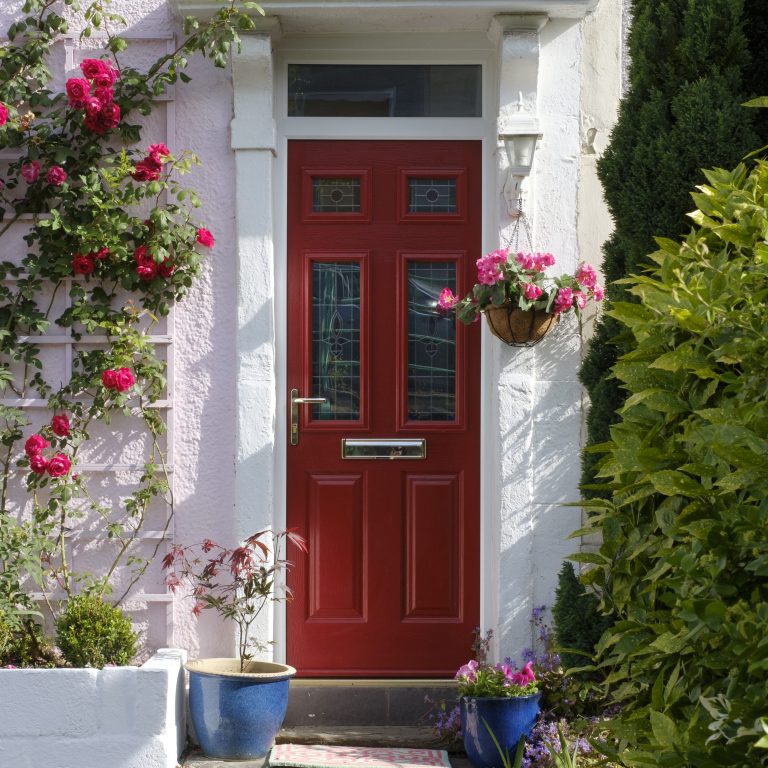Composite doors have gained popularity as a stylish and durable alternative to traditional timber and uPVC doors. That being said, understanding why they’re potentially the better alternative for you and your home might be a little confusing.
So in this article, we will explore the advantages and disadvantages of composite doors vs uPVC doors and timber doors, helping you make an informed decision for your home.

Composite Doors vs Timber Doors – Pro’s & Cons of Timber:
Timber has long been the quintessential material for doors and has seen little reinvention since it became the standard choice for homes. Its timeless, traditional appearance is widely appreciated, and it offers impressive durability, with a potential lifespan exceeding 60 years – with the caveat of requiring serious maintenance and upkeep. Timber is also highly customisable, with an extensive range of suitable outdoor paints available. All things considered, there’s a reason timber remains a trusted option for front and back doors, though it does come with its own challenges.
While robust, timber demands significant upkeep to ensure its longevity. It is susceptible to warping, water damage, and splitting, particularly after prolonged exposure to severe weather. Moreover, timber is an expensive option, especially when compared to more economical materials such as uPVC. Its high maintenance requirements and steep price make it a less cost-effective choice for many
Composite Doors vs uPVC Doors – Benefits and Drawbacks of uPVC:
uPVC has been a popular material for front and back doors since the 1980s and has proven to be a durable and stylish option. Although it lacks the traditional charm of timber, many modern homes favour its contemporary aesthetic. uPVC is low maintenance and easy to clean, making it an excellent choice for those with busy lifestyles. Its weatherproof nature is another key advantage, as uPVC is not prone to the warping issues that timber can suffer.
However, uPVC is not without its disadvantages. The door’s core is typically made of styrofoam, making it lighter than alternatives such as timber or aluminium, but also less durable. Its colour can fade or discolour over time, and while uPVC paints are available, they require considerable preparation and are harder to source than standard timber paints. Additionally, uPVC doors tend to have a relatively short lifespan of 20 to 25 years, making them the least durable of the three main options on the market.
How can composite doors combine the best of both materials without the drawbacks?
Construction and Durability: Composite doors are made from a combination of materials, including a solid timber core, heat-reflective PVC skin, and a reinforced frame. This unique construction provides leading strength, durability, and thermal performance. Endurance composite doors are engineered to withstand daily use and changing weather conditions. Offer premium quality, long-lasting elegance, and protection for homes.
Low Maintenance: One of the main advantages of composite doors is their low maintenance requirements. Unlike timber doors that need regular sanding, painting, and varnishing, composite doors only require a simple wipe-down with a damp cloth to remove dirt or grime. This makes them a practical choice for busy homeowners who want a beautiful and hassle-free entrance to their home.
Excellent Insulation: Composite doors offer excellent thermal efficiency, providing natural insulation for your home. This helps keep your home warm in winter and cool in summer, leading to energy savings and a more comfortable living environment. While timber doors also offer good insulation properties, they may require additional measures, such as draught-proofing strips, to achieve the same level of efficiency.
Aesthetics and Customisation: Composite doors are designed to mimic the look of traditional timber doors without the maintenance requirements. They are available in a wide range of styles, colours, and finishes, allowing you to find the perfect door to complement your home’s architecture and personal taste.
Composite vs uPVC vs Timber Doors – Which Should You Choose?
Composite, uPVC, and timber doors all have their own advantages. However, it is clear to see that in many ways – most notably strength and low maintenance – composite doors have a significant advantage. They are specifically designed to combine the best elements of both uPVC and timber with none of the compromises.
If you are interested in a new composite door for your home, reach out to Endurance today. You can use our door designer to start creating a new composite door, customising the style, colour, and hardware to suit your tastes and receive a bespoke quote. Alternatively, reach out to our team for more information and expert advice today.








